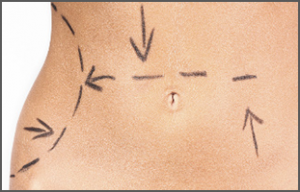4 Steps for Cosmetic Surgery: Let’s Begin
August 23rd, 2012
13.8 million people had surgery cosmetic plastic surgery procedures in the United States in 2011, according to he American Society of Plastic Surgeons (ASPS). For all of the procedures involving actual surgery, these four universal steps are followed. In this series, I will describe each of the steps in doing cosmetic surgery. Let’s start at the beginning.
Step 1: Skin Incision.
The first step in all cosmetic surgery is to cut the skin. Whenever the skin is incised through its full thickness, a permanent scar is left. By permanent, I mean the scar will never completely go away, but as cosmetic surgeons, we are trained in ways to minimize the appearance of scars. So, before the surgery starts, a surgical plan is designed and typically drawn on the skin, similar to the diagram of a football play you might have seen on TV. Careful placement and design of the incision are crucial steps to minimize leaving a visible scar, which will continue to fade substantially with time.
This initial surgical plan represents the aesthetic design aspect that is the cornerstone of all cosmetic plastic surgery. Of course, with purely elective cosmetic surgery, I have the luxury of time to plan and execute an aesthetic design. This is not always the case in a hospital setting when critical surgery is necessary.
Please check back next time for Part 2 of this series.
What About Scars?
March 14th, 2011
All surgery leaves a scar, including cosmetic surgery. However, cosmetic surgery scars may be designed to be less visible. This is particularly the case with liposuction and breast enlargement surgery. Ideally all these scars are placed in such a way to be concealed by the smallest swim suit the patient chooses to wear. Most of us have observed minor injuries or surgery. If you reflect on how the scar on a skinned knee changes over time, you might recall that process requires months to mature or fade.
Scars on the face mature quicker than scars on the back. A freshly healed scar looks pink or red and feels hard. This is the normal appearance and feel of scar tissue within the first six weeks of surgery. New collagen that is deposited by healing cells, feels hard to the touch. In addition, the process of healing requires increased blood flow. The large number of capillaries make the new scar look red. Scar maturation is the process by which your body changes (remodels) the collagen and the capillaries in the scar.
Fortunately this process usually cycles to completion and results with a soft scar that is barely visible. Think of scars being a kind of Thanksgiving turkey “doneness” indicator. When the timer pops up, the turkey is done. When your scars are soft and no longer pink, you have an indication that your internal healing is also complete. In both cases it can take longer than you hope!

